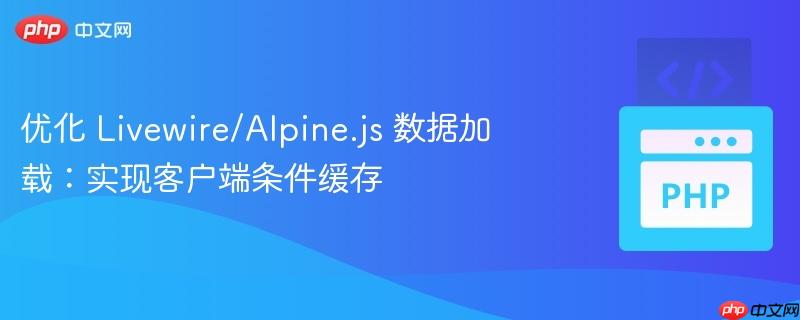
在构建动态 web 应用程序时,数据加载的效率是提升用户体验的关键因素。livewire 和 alpine.js 的组合为我们提供了构建响应式和交互式用户界面的强大能力。然而,在处理如级联下拉菜单这类场景时,如果不加优化,每次用户选择都可能触发对服务器的重复数据请求,即使这些数据之前已经获取过。这种冗余的请求不仅增加了服务器的负担,也可能导致用户界面出现不必要的延迟。本文将详细介绍如何通过在客户端实现数据缓存,有效解决这一问题。
在不进行优化的 Livewire 应用中,我们通常会使用 wire:change 指令来监听下拉菜单的变化,并触发 Livewire 组件中的方法来获取数据。
示例:传统 Livewire 下拉菜单
<select wire:model="selectedCountry" name="selectedCountry" id="selectedCountry" wire:change="fillStates">
<option value="">Select Country</option>
@foreach($this->countries as $country)
<option value="{{ $country->id }}">{{ $country->name }}</option>
@endforeach
</select>对应的 Livewire 组件方法可能如下:
// Livewire Component
public $selectedCountry;
public $states = []; // 用于存储已获取的州/省数据
public function fillStates()
{
// 每次选择都会触发此方法,并查询数据库
$fetchedStates = State::where('country_id', $this->selectedCountry)->get();
if($fetchedStates->count()) {
$this->states[$this->selectedCountry] = $fetchedStates;
} else {
$this->states[$this->selectedCountry] = collect(); // 确保即使无数据也有空集合
}
}这种模式的局限性在于,无论用户是否曾选择过某个国家并获取过其对应的州/省数据,每次下拉菜单 selectedCountry 发生变化时,fillStates 方法都会被调用,进而向数据库发起新的查询。这对于频繁切换或重复选择的场景来说,效率低下且浪费资源。
为了实现客户端缓存,我们需要对 Livewire 组件进行一些调整,主要是确保其公共属性能够被 Alpine.js 访问,并且 fillStates 方法能够正确地更新这些属性。
// app/Http/Livewire/CountryStateDropdown.php
namespace App\Http\Livewire;
use Livewire\Component;
use App\Models\Country;
use App\Models\State;
class CountryStateDropdown extends Component
{
public $countries;
public $selectedCountry;
public $states = []; // 公共属性,用于在 Livewire 内部缓存已获取的州/省数据
public function mount()
{
$this->countries = Country::all();
}
/**
* 根据选定的国家ID获取州/省数据。
* 此方法仅在 Alpine.js 判断客户端无缓存时被调用。
*/
public function fillStates()
{
// 只有当 Livewire 内部也未缓存此国家数据时,才进行数据库查询
if (!isset($this->states[$this->selectedCountry])) {
$fetchedStates = State::where('country_id', $this->selectedCountry)->get();
$this->states[$this->selectedCountry] = $fetchedStates;
}
// 注意:此方法不再需要显式返回数据,因为 Alpine.js 将直接通过 @this.get('states') 访问 $this->states 属性。
}
public function render()
{
return view('livewire.country-state-dropdown');
}
}在上述 Livewire 组件中:
解决方案的核心在于利用 Alpine.js 在客户端管理 selectedCountry 的状态,并维护一个 cachedStates 对象作为客户端缓存。当 selectedCountry 变化时,Alpine.js 会首先检查 cachedStates。如果数据已存在,则直接使用;否则,才通过 @this.call() 调用 Livewire 方法获取数据。
Blade 模板中的 Alpine.js 集成
<!-- resources/views/livewire/country-state-dropdown.blade.php -->
<div x-data="{
selectedCountry: @entangle('selectedCountry'), // 将 Alpine.js 的 selectedCountry 与 Livewire 属性同步
cachedStates: {}, // 客户端缓存对象,结构为 { country_id: [state_objects] }
}"
x-init="$watch('selectedCountry', async (value) => {
if (value) { // 确保有实际的国家被选中
// 检查当前选中的国家的数据是否已存在于 Alpine.js 的 cachedStates 缓存中
if (! (value in cachedStates)) {
// 如果不在缓存中,则调用 Livewire 方法从服务器获取数据
await @this.call('fillStates');
// 从 Livewire 组件的公共 $states 属性中获取特定国家的数据,并存储到 Alpine.js 的 cachedStates 中
// @this.get('states') 返回的是 Livewire 组件的整个 $states 数组
// 因此我们需要通过 [value] 索引来获取特定国家的数据
cachedStates[value] = @this.get('states')[value];
}
// 如果数据已在缓存中,则不执行 @this.call(),直接使用 cachedStates[value]
} else {
// 如果没有选中任何国家,可以清空或重置相关状态
// 例如:selectedState = null;
}以上就是优化 Livewire/Alpine.js 数据加载:实现客户端条件缓存的详细内容,更多请关注php中文网其它相关文章!

每个人都需要一台速度更快、更稳定的 PC。随着时间的推移,垃圾文件、旧注册表数据和不必要的后台进程会占用资源并降低性能。幸运的是,许多工具可以让 Windows 保持平稳运行。

Copyright 2014-2025 https://www.php.cn/ All Rights Reserved | php.cn | 湘ICP备2023035733号